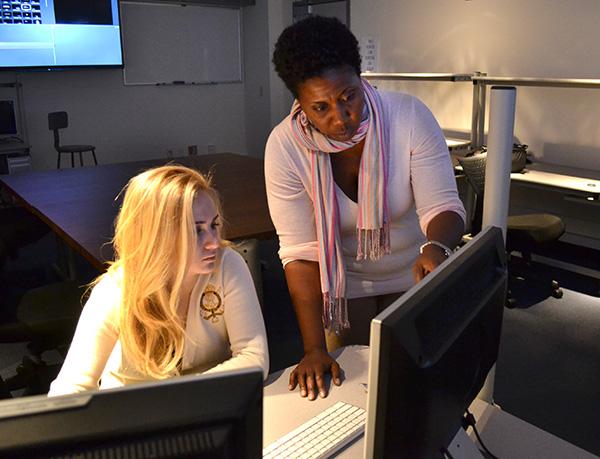GW may not have a football team, but it’s not stopping students from reporting on the sidelines.
One professor in the School of Media and Public Affairs has begun integrating sports journalism into her classes as faculty have seen an increase in demand from students.
Giving students more opportunities to practice sports journalism within the school could help SMPA compete with other journalism programs that have strong sports reporting classes, such as Syracuse University and the University of Maryland.
Imani Cheers, an assistant professor in SMPA, said she would like GW to offer a degree in sports journalism, but for now, she’s providing opportunities through her existing classes.
“I’m a huge sports fan and I’ve had experience as a sports journalist, so I’m looking forward to not only sharing some of my knowledge in the field with students, but to just offer them a wider variety of options,” she said.
Kim Gross, SMPA’s associate director, said the only sports journalism courses taught at SMPA are those occasionally offered through its specialized reporting course, which focuses on journalism in certain fields such as business or medicine.
“At this time, we do not have any plan to start a sports journalism program or degree,” Gross said. “We also don’t have specific plans for a permanent sports journalism class in the new curriculum.”
In the meantime, Cheers has offered aspiring SportsCenter hosts and Sports Illustrated writers the chance to cover games in the D.C. area for her classes.
“Here at SMPA, we really try to listen to the feedback that students give us about the program and about the department offerings,” Cheers said. “Over the years, students have expressed interest about sports journalism, and we’ve heard the cries. We’ve heard the feedback.”
Students in Cheers’ online journalism workshop course have gone to a D.C. United game, Washington Capitals game and Washington Wizards practice. Cheers had tried to bring a group of students to cover the World Cup in Brazil this summer, but two people short of her enrollment goal, the trip was canceled.
Ben Remaly, a sophomore majoring in journalism, wrote a piece about Derek Jeter in his introduction to news writing and reporting class last year, and filmed a D.C. United game for his digital media class with Cheers.
“I do not think a sports journalism class is necessary to be a sports journalist, but I think connecting students and teachers that have a common interest in covering sports and really working with students that can give specialized feedback could be helpful,” Remaly said.
Matthew Seedorff, a reporter and anchor for the K2 ABC news team in Wyoming, graduated from SMPA last spring and said he wished the school had less of an emphasis on political journalism.
“While I was a student, I was always very frustrated that SMPA did not offer a broader range of journalism courses, especially since our rival school Maryland has such an impressive sports journalism program,” Seedroff said.
George Solomon, the director of the Shirley Povich Center for Sports Journalism at the University of Maryland, said his program tries to give students interested in covering sports a boost when looking to break into the industry.
“We think sports journalism is really important in the spectrum of media since it is a growing landscape,” Solomon said.
For schools that plan to launch sports journalism programs, Syracuse University’s Newhouse Sports Media Center Director John Nicholson warned against letting the topic make courses less serious than their news counterparts.
“If you go to launch such courses, take them seriously. Make them a series of courses with serious intent,” Nicholson said. “There is a trend of a lot of young men and women who want to go into sports media, and it shouldn’t be just for amusement of students.”







